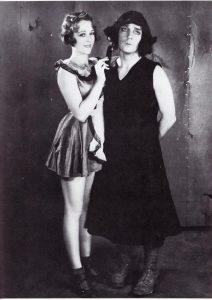Drag in the Cinema, The Early Years of Sound
In the 1990s TGForum had an expert on drag in movies who wrote a series of articles for us. Laurie Sheril was her name and she covered the instances of movie crossdressing through the different historical periods of film-making. We’re bringing her series out of the archives as a Retro Rerun beginning with her article on drag in the early years of the talkies.
“You Ain’t Heard Nothin’ Yet!” With those words in The Jazz Singer (1927), Al Jolson ushered in the era of sound in the movies. Now not only could we see the female pretenders, but we could hear them, too. It became no longer just “looking like a woman,” you had to sound like one, too.
As before, comedies and comedians were the ones to take the greatest advantage of drag situations. Laurel and Hardy made the successful transition from silents to sound. Building on their previous silent short featuring Stan in drag, That’s My Wife, the boys went it one better in 1933 in their film, Twice Two. Here both Stan and Ollie played themselves as well as each other’s wives. The situation gave them the opportunity to play-off each other in the usual way as well as in the opposite genders. As usual the results were disastrous and — of course hilarious.
Another comedy duo, not nearly as well known as Laurel and Hardy (nor as successful ) were Bert Wheeler and Robert Woosley. Beginning with 1930’s The Cuckoos, the duo made a string of pictures for RKO. One made in 1932, Peach O’Reno, afforded Wheeler the opportunity to spend a great deal of the picture in drag. The plot revolved around a divorce “racket” run by the two. Wheeler has to resort to drag in order to elude a gambler who vows to “get the guy” who arranged his wife’s divorce. In a short blonde wig, Wheeler made a quite fetching and realistic-looking dame.
Buster Keaton had some absolute classics of the silent screen, but sound wasn’t nearly as kind to him. However, 1930’s Doughboys for MGM did display some of the Great Stoneface’s charm. This comedy based on some his own military exploits has one scene of a “show” in camp that said doughboys put on. Naturally the show requires them to dress up as girls. While most of the other “players” seem to be camping it up pretty good, Keaton doesn’t look half-bad in make-up and less than glamorous clothes.
During the early days of sound there were a lot of great comedy teams, The Marx Brothers, Laurel & Hardy, The Three Stooges and — The Ritz Brothers. One of their films was a 1937 musical called On the Avenue that starred Dick Powell, and an up and coming Alice Faye. One number in the film was called Slumming on Park Avenue. Here Faye was dressed in a perfectly “outrageous” outfit (not only by 1937 standards either!) for the number. Harry Ritz matched her, wearing the same outfit, for comic effect!
I guess we could say that anybody who was anybody comedy-wise somehow managed to get into drag in those screwball ’30s comedies. From Mickey Rooney to Red Skelton and everybody in-between, the early days of sound films provided lots of laughs and lots of drag!
Care to make a comment on this post? Login here and use the comment area below.
Category: Media, Transgender History















